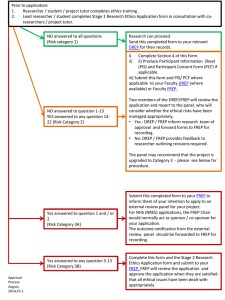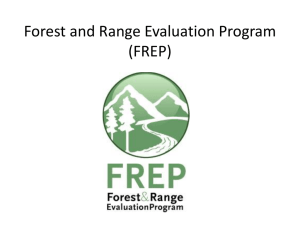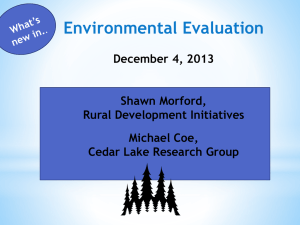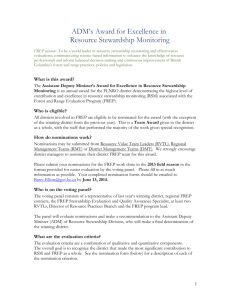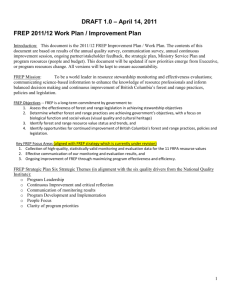FREP Strategic Plan final draft (for ADMs) November 8
advertisement
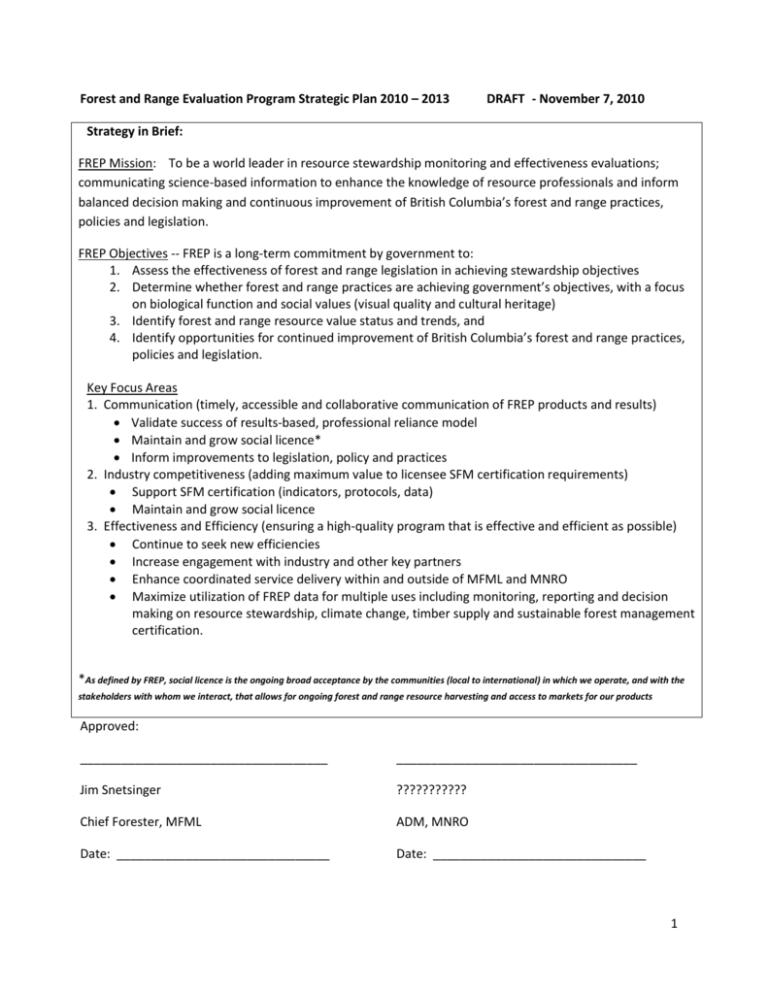
Forest and Range Evaluation Program Strategic Plan 2010 – 2013 DRAFT - November 7, 2010 Strategy in Brief: FREP Mission: To be a world leader in resource stewardship monitoring and effectiveness evaluations; communicating science-based information to enhance the knowledge of resource professionals and inform balanced decision making and continuous improvement of British Columbia’s forest and range practices, policies and legislation. FREP Objectives -- FREP is a long-term commitment by government to: 1. Assess the effectiveness of forest and range legislation in achieving stewardship objectives 2. Determine whether forest and range practices are achieving government’s objectives, with a focus on biological function and social values (visual quality and cultural heritage) 3. Identify forest and range resource value status and trends, and 4. Identify opportunities for continued improvement of British Columbia’s forest and range practices, policies and legislation. Key Focus Areas 1. Communication (timely, accessible and collaborative communication of FREP products and results) Validate success of results-based, professional reliance model Maintain and grow social licence* Inform improvements to legislation, policy and practices 2. Industry competitiveness (adding maximum value to licensee SFM certification requirements) Support SFM certification (indicators, protocols, data) Maintain and grow social licence 3. Effectiveness and Efficiency (ensuring a high-quality program that is effective and efficient as possible) Continue to seek new efficiencies Increase engagement with industry and other key partners Enhance coordinated service delivery within and outside of MFML and MNRO Maximize utilization of FREP data for multiple uses including monitoring, reporting and decision making on resource stewardship, climate change, timber supply and sustainable forest management certification. *As defined by FREP, social licence is the ongoing broad acceptance by the communities (local to international) in which we operate, and with the stakeholders with whom we interact, that allows for ongoing forest and range resource harvesting and access to markets for our products Approved: ____________________________________ ___________________________________ Jim Snetsinger ??????????? Chief Forester, MFML ADM, MNRO Date: _______________________________ Date: _______________________________ 1 Forest and Range Evaluation Program 3 Year Strategic Plan 2010 – 2013 British Columbia’s Forest and Range Evaluation Program (FREP) is led by the Ministry of Forests, Mines and Lands (MFML), in partnership with the Ministry of Natural Resource Operations (MNRO) and the Ministry of Environment (MOE). The Forest and Range Practices Act and Regulations provide for a resultsbased, forest and range management framework in British Columbia that includes professional reliance as a foundational principal. Under the results-based model, government evaluates compliance with the law (C&E) and evaluates the effectiveness of forest and range practices in achieving management objectives, including sustainable resource management (FREP). For the purposes of FREP, sustainable resource management means: • Managing forest resources to meet present needs without compromising the needs of future generations • Providing stewardship of forest and rangelands based on an ethic of respect for the land. • Conserving the resource values identified under FRPA and its regulations, namely: biodiversity, cultural heritage, soil, water, fish, forage and associated plant communities, timber, recreation, resource features, visual quality, and wildlife. This strategy outlines the key program focus areas and associated key outcomes for the next three years in response to MFML and MNRO priorities, staffing levels and program budgets and an ongoing focus on quality and continuous improvement. The FREP mission, goals, priorities and focus areas are aligned with the Premier’s goal of leading the world in sustainable environmental management and the MFML vision, service plan, and business response. This strategy will be re-examined annually to ensure it remains current and relevant. MFR (MFML) Vision: A prosperous forest and range sector based on sustainably managed resources that provides benefits now and for generations to come. FREP Mission: To be a world leader in resource stewardship monitoring and effectiveness evaluations; communicating science-based information to enhance the knowledge of resource professionals and inform balanced decision making and continuous improvement of British Columbia’s forest and range practices, policies and legislation. FREP Objectives -- FREP is a long-term commitment by government to: 1. Assess the effectiveness of forest and range legislation in achieving stewardship objectives 2. Determine whether forest and range practices are achieving government’s objectives, with a focus on biological function and social values (visual quality and cultural heritage) 3. Identify forest and range resource value status and trends, and 4. Identify opportunities for continued improvement of British Columbia’s forest and range practices, policies and legislation. 2 For the next three years, FREP will focus on the three following key areas: Key Focus Area 1. Communication Timely, accessible and collaborative communication of FREP products and results Linkage to Key MFML and MNRO Priorities Sustainable management of forest and range resources Validation and success of the results-based, professional reliance model Continued improvement of legislation, policy and practices 2. Industry competitiveness Enhanced industry competitiveness through adding maximum value to licensee SFM certification requirements Working with licensees to gain efficiencies in meeting their SFM Certification monitoring obligations Maintaining/growing social licence 3. Effectiveness and Efficiency Seeking new efficiencies in all activities and operations Ensuring a high-quality program that is effective and efficient as possible Engaging and consulting with key partners Coordinating service delivery within the resource management agencies Key Outcomes/goals Known outcomes (status and trends) of legislation, policy and practices plans, with respect to resource value stewardship Determining whether government’s objectives for the forest and range resource values have been met Timely and effective communication of monitoring results Improved skills and knowledge on which to base individual and collective continuous improvement and the success of professional reliance Enhanced trust between resource management professionals, and; for professionals by the public A culture where continuous improvement of skills, knowledge, abilities and decision making, based on the best available knowledge, is the norm Outcomes: Enhanced integration of FREP with certification inspections, audits, data collection and reporting Readily accessible FREP products to help meet licensee SFM certification requirements Extensive use of FREP results by certifying bodies in evaluating conformance Enhanced indicator and protocol feedback for FREP – allowing for enhanced continuous improvement Outcomes: Greater flexibility for districts in resource stewardship monitoring implementation Increased licensee engagement Multiple-value landscape-level assessments (starting with biodiversity) to provide context for stand/site level monitoring and allow for reporting of current landscape status Detailed analysis of a multi-value assessment approach Maximize utilization of FREP data for multiple uses including monitoring, reporting and decision making on resource stewardship, climate change, timber supply and sustainable forest management certification. Intensive effectiveness evaluations where issues that require immediate assessment emerge 3 An annual FREP improvement plan / work plan is developed in order to guide the implementation and achievement of the goals in the FREP Strategic Plan. The improvement plan is based on ongoing lessons learned, an annual quality assurance survey, an annual continuous improvement workshop, and other input from partners and stakeholders. The improvement plan / work plan can be found at http://www.for.gov.bc.ca/hfp/frep/pmgmt/index.htm FREP Resource Stewardship Monitoring (RSM) Implementation Schedule RSM Implementation Schedule and sampling targets: Target for each district (new 2010 district boundaries) is 40 samples per year Minimum samples of water quality, biodiversity, fish/riparian and visual-quality resource value samples are required for each district. Beyond minimums, districts select resource values, and number of samples per value, based on local priorities (guidance provided, separate document) Meeting sampling targets may include pilot participation and targeting specific innovative practices/approaches Discussion of district monitoring activities should include input from local licensees and other key stakeholders and (or) partners FRPA Resource Value Water quality Fish – riparian Stand-level biodiversity Visual quality Cultural Heritage (CHRV) Timber (Stand Development Monitoring (SDM)) Landscape-level biodiversity (LLBD) Water quality and Riparian watershed (WS) Multiple-resource value assessments Wildlife (MOE led implementation) Soils (site-level) Soils (terrain level) Forage Year (and minimum target number of samples per district*) 2010 2011 2012 2013 5 per year 5 per year 5 per year 2009-2011 total of 30 samples No sampling these years Pilot No minimum Pilot No minimum (Recommend starting two to three years pre-timber supply review to allow sufficient time to collect 30 samples) Development Pilot Implementation No minimum Development and pilot Implementation No minimum Development and pilot Potential Implementation No minimum Development, Piloting and Implementation underway – implementation by MOE Development Pilot Implement No minimum Development and pilot Implement No minimum No minimums *Notes: final sample numbers will be decided in consultation with a statistician, sample numbers for all values will be reviewed again once FRPA has been reported on (most data to date has been FPC) and district working group will be formed to finalize district flexibility criteria 4
